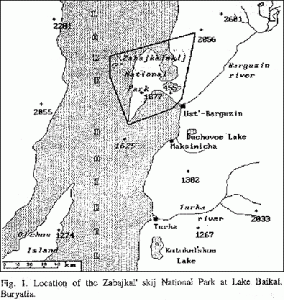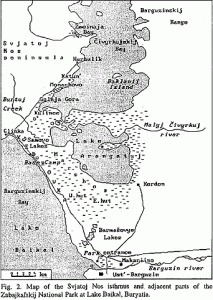Institute of General and Experimental Biology, SB RAS, Ulan-Ude
Head of the Institute:
Vladimir M.Korsunov, Doctor of Biological Sciences, Professor
6 Sakhyanovoi Str., Ulan-Ude, 670047, Russia
Tel. (3012) 331211, Fax: (3012) 330134,
email: ioeb@bsc.buriatia.ru
Principal researchers:
N.M.Pronin, Ph.D. (Biology),
Head of the Laboratory of Parasitology and Ecology of Hydrobionths
B.B.Namsaraev, Doctor of Sciences (Biology),
Head of the Laboratory of Microbiology
A.V.Sokolov, Ph.D. (Biology),
deputy director of the Eastern-Siberian Centre of Fishery
Project objectives
- to establish patterns of spatial distribution of biological diversity at the level of species and biocoenosis along the transection: Lake Arangatui – Chivirkui Bay – open Baikal with the replacement of different trophic areas (polytrophic – eutrophic – mesotrophic – oligotrophic) of the water-basin, interaction of Siberian, Baikal-Siberian and Lake Baikal fauna in connection with the problem of their relative non-mixing;
- to show the way of co-evolution of partners in the parasitary system during the development of palearctic parasites, endemic fauna of invertebrates and vertebrates as new species of intermediate, supplementary and definitive hosts;
- to work out a scheme of management of fishery of the Chivirkui fishery area as part of Zabaikal’skii National Natural Park.
Background and significance of objectives
There are considerable data on comparative research of hydrobiological characteristics of water-basins of different trophic type and of the influence of different factors on processes of eutrophication in ecology. Chivirkui Bay is a super-unique water-basin due to the existence of natural areas of different trophity. A natural change of the trophic type of water-body: eutrophic – mesotrophic – oligotrophic – ultraoligotrophic along with the longitudinal profile of the Bay with changing of its depth from 4 m to 100 m is noted. Gradual alternation of the fauna: from Siberian to Baikal-Siberian and to endemic Baikalian one is marked. There is a large number of relatively isolated gulfs with peculiar temperature conditions. The Bay is tied with the large Lake Arangatui situated on the isthmus by a little river. There is a number of small lakes with reduced fauna on the isthmus. Chivirkui Bay of Lake Baikal is entirely part of the territory of Zabaikal’skii National Natural Park, 40 km away from the village of Ust-Barguzin, 5 km away from the pier of fishermen’s village of Kurbulik (see Fig. 1). Chivirkui Bay is the most cutting into the mainland and relatively isolated one among other Baikal bays, with numerous unique gulfs (see Fig. 2).
At present, there are very interesting, but isolated or fragmentary data on some taxonomic or ecological groups of hydrobionts. The diversity and activity of micro-organisms of water and bottom precipitation of Chivirkui Bay have not yet been researched. Fragmentary investigations of any physiological groups of micro-organisms give no idea about their role in the action of the lake ecosystem. The changes of environmental conditions from shallow-water to deep-water give the possibility of comparative research into the biogeochemical activity of micro-organisms.
A. Ya.Bazikalova (1945) established a varying distribution of gammarids along the profile of the Bay and in its gulfs. The poorest composition of gammarid fauna is typical of the southern shallow-water part of the Bay (Pronin et al., 1986). The diversity of fauna is increasing in the part near the open Baikal. However, the spatial distribution of abundance and biomass of this group of the benthos has another pattern. The distribution of zooplankton is uneven, too. Its abundance in June in central and south-eastern parts of the Bay does not exceed 80000 spesies/m3. In the northern and south-western part the abundance of zooplankton was less than 40000 spesies /m3 (Sokolnikov, 1994). Different directions of seasonal abundance of zooplankton in the other part of the Bay (from 40 to 160000 spesies/m3) demand deeper research of regularities of its distribution in time and space.
Among the fish of the Bay, there are coinciding species in eutrophic, mesotrophic, oligotrophic and ultraoligotrophic areas and in different parts of water-basin. The structure of parasitocoenosis is determined by the environment and interrelations between parasites and hosts. The parasite species composition of fish integrates its trophic and topic connections. The comparison of community of parasites of hydrobionths arranged into areas of appointed trophity allows one to reveal physiological and ecological factors that determined parasite species diversity.
Especially interesting information may be obtained from comparative analysis of fauna of blood parasites of fish in different faunistical complexes.
At the first stage the research of the following taxonomic and ecological groups is supposed to be conducted:
- microorganisms (Namsaraev B.B., Kozyreva L.P. and others);
- zooplankton (Sokolnikov Yu.A.);
- amphipodes and communities of their parasites and symbionts (Kritskaya U.A., Baldanova D.R., Takhteev V.V., Pronin N.M.);
- fish and communities of their parasites (Pronin N.M., Sokolov A.V., Baldanova D.R., Peterfeld V.A., Pronina S.V., Hamnueva T.R. and others).
Research plan: approaches and methods
General hydrobiological survey of the open part of Chivirkui Bay, its gulfs and Lake Arangatui will be made and general quality hydrobiological features will be estimated. Basing on the results of a general hydrobiological survey, constant transection of stations along the central axis and series of station on the longitudinal hemiprofile in the littoral of the different part of the bay (eutrophic, mesotrophic, oligotrophic) will be established for the periodical survey.
All materials will be sampling and processed according the wide-accepting methods. Specific diversity will be defined by Shannon`s index (Megarran, 1992). Spatial distribution will be described by mapping of aquatoria. Diversity of microorganisms will be described by microscopic, cultural, physiological, molecular-genetic and serological methods. The activity of microorganisms will be determined by fermentative, radio-izotope and chemical methods. The composition of parasites will be determined by method of I.E.Bykhovskaya-Pavlovskaya (1985). Monitoring of the state of the fisheries resources in the aquatoria of the National Parks of Lake Baikal will be based on the population approach of determination of the abundance of local fish populations in Chivirkui Bay (the method of area, hydroacoustic survey, modelling). The main biological indices of fish will be characterised on the basis of materials of trawling surveys.
Expected results
Will be presented:
- Characteristics of specific and biocenotic diversity of hydrobionths of Chivirkui Bay and Lake Arangatui and the series of the maps on distribution of the different groups of hydrobionths in the other seasons.
- Characteristics of ecological valence of Baikal hydrobionths and possibility their introduction and naturalisation in the water-basins of Siberia and Palearctic. Will be established the peculiarities of expansion of palearctic parasites to the ecosystem of Baikal and co-evolution with Baikal endemics.
- The maps of fluctuating borders of the areas with the different trophity and fishery maps of aquatoria of protected territories of Baikal.
List of publications of participants related to the project
-
Hoff M.H., Pronin N.M., Baldanova D.R. Parasites of Lake herring (Coregonus artedii) from Lake Superior, with special reference to use of parasites as markers of stock structure // J. of Great Lakes research. – 1997. – Vol. 23, ą 4. – P. 458-467.
-
Pronin N.M., Selgeby J.H., Litvinov A.G., Pronina S.V. Comparative Ecology and Parasite Fauna of Exotic invaders in the Great Lakes of the World: rotan (Perccottus glehni) in the Lake Baikal and ruff (Gimnocephalus cernuus) in the Lake Superior // Siberian J. of Ecology. – 1998. – ą 5. – P. 397-406. (In Russian).
-
Pronina S.V., Pronin N.M. Interrelations in the systems “Helminths-Fish”. – Moscow: Nauka, 1988. – 176 p. (In Russian).
-
Pronin N.M., Rinchino V.L., Kudryashov A.S., Bekman M.Yu. Intermediate hosts of cestoda Cyathocephalus truncatus in the water-basins of Baikal-Amur basin. Problems of biocenology of helminths. – Moscow: Nauka, 1986. – P. 72-79. (In Russian).
-
Bronte C.R., Fleischer G.W., Maistrenko S.G., Pronin N.M. Discrimination of Baikal omul (Coregonus autumnalis migratorius) as determined by whole-body morphometrics // J. of Fish Biology. – 1999. – ą 1.
-
Sokolnikov Y.A. Peculiarities of spatial and temporal distribution of zooplankton of shallow waters of Baikal: Selenginskoye melkovodye, Bargusin Bay and Severobaikalskoe melkovodye // Siberian J. of Ecology. – 1998. – ą 5. – P. 435-440. (In Russian).
-
Baldanova D.R., Pronin N.M. Seasonal dinamics of invasion of salmonoids of Lake Baikal by acanthocephalans // Parasitology. – 1998. – ą 1. – P. 78-81. (In Russian).
Fig. 1. Transbaikalian National Park on Lake Baikal, Buryatia.
Fig. 2. Isthmus of the Svyatoj Nos peninsula and adjacent surroundings, Lake Baikal, Transbaikal National Park on Lake Baikal, Buryatia.


